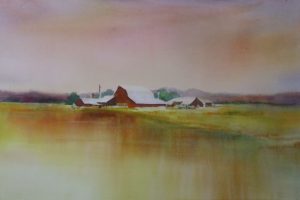 What do I mean by: Keep the color moving?
What do I mean by: Keep the color moving?
Think of it this way: don’t let any square inch of your painting have the same hue+value as the square inch next to it.
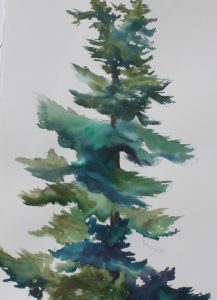 Our eyes feast on this color change. Learn how to do it and then make yourself do it. It is more work than keeping going with whatever color you started with.
Our eyes feast on this color change. Learn how to do it and then make yourself do it. It is more work than keeping going with whatever color you started with.
On the left is a simple demo of a big lone fir tree. All green. But notice how each branch shifts in the hue and value of its colors.
This is wet blending — simply wetting an area and adding color. 
In the close up, you see the dark trunk dissolving into the dark green (thalo green + quin. violet ). Then that moves into a bluer green (adding thalo blue) and out into a yellow green (addition of quin gold).. etc. 
A lot of rinsing of your brush, ofblotting it on your tissue, adding a new color and going back into the area you had wet on the paper.
You move on, adding more clean water and extend the shape. You stop to look, then try to match hue and value, staying alert for changes.
Below is another outdoor attempt mixing the colors into one another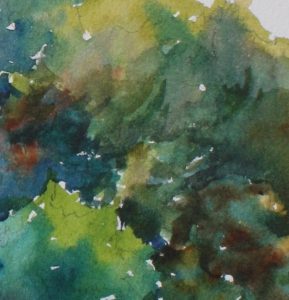 — on the page.
— on the page.
You need to be considering
- how wet the paper is,
- therefore how much water on your brush?
- which color to choose
- how dark or light a version of that pigment – how much pigment in relation to the water on your brush?
Next:
- Put it down

- Look at it
- Change or adjust it
- Keep going – repeating the steps
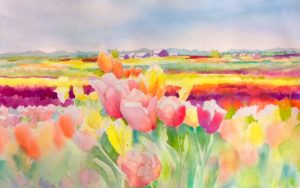
You have been wet blending. It isn’t that different if you are doing wet-on-wet. An example is in the lead photo of about 5 sq. inches of an iris painting, and in this tulip field scene.
By keeping the colors moving as shown in the fragment of the tulip painting the soft distance is implied, colors are moving, changing. In addition, if you look at the near tulips you see the color changes are also occurring within each petal. Check me on the square inch rule. Do the colors keep changing?

It is easier to achieve color shifts in glazing because you have more than one chance to change the colors.
When you are glazing – even if it is a blue over a blue — be sure that there is at least some shift in hue a more violet blue or a more green blue over the first one, or pigment – cerulean blue over thalo blue that had shifted to violet blue or green blue.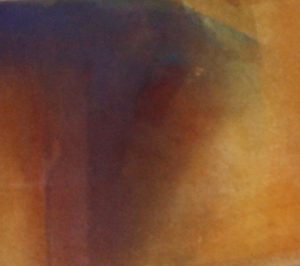
This is a close-up fragment from a painting of an old house, layers of glazing and color shifts as I created a color-filled dark shadow under the eve.
Would you rather have this dark or
This? 
If you aren’t comfortable with how to keep your color moving, I suggest practice. Lots of it, on the back of old paintings or anywhere. Try wet blending, wet on wet, and glazing until you are able to keep the color moving.

I am betting you will never go back to flat continuous color. It’s a painting – not a wall! I can’t wait to see what you do.
Happy painting,
Caroline
